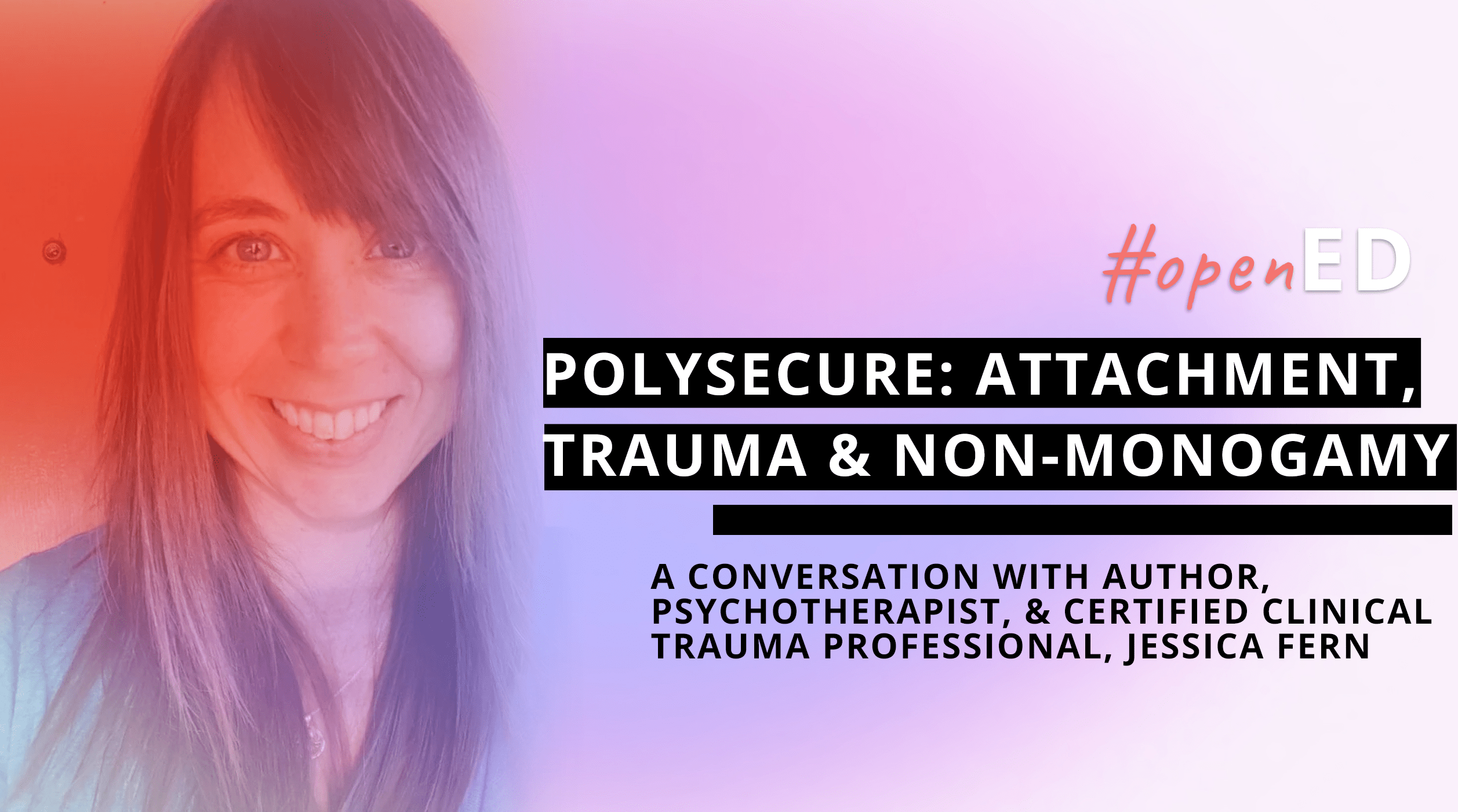Here’s The Secret To Feeling Secure In Non-Monogamy
Psychotherapist, certified clinical trauma professional, and author Jessica Fern joined us last January for our educational series #openEd. In this series, we talk to experts who help us break down complex topics related to non-monogamy, sexuality, and kink.
Jessica, who wrote the infamous book Polysecure: Attachment, Trauma, and Consensual Non-Monogamy, works with individuals and couples in multiple partner relationships who no longer want to be limited by their reactive patterns, cultural conditioning, insecure attachment styles, and past traumas. Below is a transcript of our #openEd with her, edited down for clarity and brevity. The full video is available here on our Youtube channel.
The research on love and relationships consistently finds that understanding our attachment styles is an important part in creating healthy and fulfilling relationships. But how that applies to non-monogamous relationships has been really unclear. To no surprise, the majority of the resources and advice and books and audio programs that are available on how to create a securely-attached, romantic relationship, really assume monogamy.
Whether it’s intentional or not, these resources have encouraged highly mononormative practices, often leaving non-monogamous folks feeling demoralized, or even pathologized, when they read about attachment. And at the very least, people feel like, well, I know this whole attachment theory thing is important for some reason, but I’m at a loss on how to do it with my multiple partners.

Secure attachment is not just for the monogamous. So many non-monogamous people have secure, loving, healthy relationships with multiple partners and multiple metamours. And so really, my intention is to lift that lens of mononormativity that the attachment theory has been described through, so that we can really apply these important gems of attachment theory.
READ MORE: What The &$*# Is Ethical Non-Monogamy?
What Attachment Theory Means For Non-Monogamous Folks
In my years of working with non-monogamous clients, I observed that going from monogamy to non-monogamy can really expose an insecure relationship. Monogamy can serve as a standard for actual secure attachment because the rules and the ways of being in that structure of monogamy are so strong that many times, all you have to do is sort of fall back on the structure to create that sense of safety. Like, oh, just the fact that we’re married, the fact that we have kids, seems like those structural commitments people depend on. And then you open up the relationship and it can expose like, oh, maybe I don’t actually feel very secure with you; our relational experience of how we treat each other and how we show up for each other doesn’t actually feel very safe and secure.
On a similar note, the opening up process, or changing relationship paradigms, can expose a personal insecure attachment. So whether you’re opening up solo or from a secure marriage, that process of lifting that structure of monogamy can expose your own history that might have been buffered through being in a monogamous structure.
One of the things that I’ve seen that’s really difficult with attachment and non-monogamy is that polyamory non-monogamy are inherently insecure. It’s a less secure structure than monogamy ostensibly. Non-monogamy doesn’t have the security at the societal level, at the cultural level, at the global level, that is really created for monogamous couples. You don’t have that, oh, I’m with you because you’re the one, you’re the only, you’re ‘the best’. Or you don’t have that, my partner is the first one that I turn to and I’m the first one they turn to. Those kinds of securities don’t exist in the same way for non-monogamy.
Of course, I think that inherent insecurity can be a really good thing. It can keep people on their toes and ensures that we don’t take our partners for granted or become complacent in our polyamorous relationships in the same way that people might in monogamy. On the other hand, that inherent insecurity can be really dysregulating for a lot of people’s attachment system. Being non-monogamous can mimic an insecure environment.
Let’s say we have a situation where there’s partner A and there’s partner B. And partner A has gotten used to a certain amount of attention and a certain frequency and rhythm of communication and time together. And it feels good. And then partner B gets another partner, and then they’re not able to offer the same level of attention and availability that they did before. And often, it’s unintentionally, but they wind up becoming more inconsistent, less predictable, or they’re not as accessible as they were before. When this happens, partner A just gets blamed. Like, you’re being insecure, you’re being jealous. But really, in this case, it’s the relationship that’s no longer providing the same level of attachment, safety, insecurity that it previously was. And this is really hard.
Another example is that non-monogamy can also mimic the disorganized environment. So the common example I’m thinking of is usually from a monogamous couple where they’ve been sort of each other’s go to a person where they’re each other’s everything. And then as you open up, that person who used to be your comfort for everything is now the person who’s triggering you and they might not be intentionally triggering you. They might be doing everything within your agreements but their actions start becoming extremely threatening. And then you have this feeling of like, I want you, I don’t want you, I want to move toward you, please come for me, but you’re the one I want to move away from.
In non-monogamy, we can have what is called primal attachment panic. We are wired to be in connection for our survival so emotional disconnection feels like death, right? Emotional disconnection, then, registers in our nervous system as a huge death threat. And so there’s a quote from Sue Johnson that captures it as, “separation distress arises when attachment bond is threatened or a secure connection is lost.”
There are other kinds of emotional bonds based on shared activities or respect. And when they are broken, a person may be distressed, but that distress does not have the same intensity or significance as when an attachment bond is called into question. Emotional and physical isolation from attachment figures is inherently traumatizing for human beings. It’s a heightened sense, not simply a sense of vulnerability and danger, but also helplessness. So for those of you that have had a complete meltdown when your partner was on a date with somebody else, even though you cognitively knew nothing’s wrong, you were going into primal attachment panic. Even if it doesn’t make logical sense, emotionally and somatically you felt disconnected and separate from your attachment figure. A lot of people are calling this jealousy and it’s not really jealousy at all.
One of the other things that I’ve seen is that in non-monogamy, we can have a mismatch of our attachment expectations. So a lot of people, even in non-monogamy, still go on the relationship escalator and they sort of move towards a certain flavor of bonding and commitment. Not everybody wants that and that’s okay. It’s both okay to want attachment-based relationships and it’s okay to want connections that aren’t necessarily attachment-based. And so, what I mean by that is, you might have connections and relationships with people where there’s a lot of love, there’s a lot of wonderful things about the time you spend and the connection you have, but you don’t necessarily want to be showing up to meet those attachment needs in a consistent, reliable, attuned way. That there can be a mismatch and that can be really confusing and painful.
The nice thing about non-monogamy is that when there’s a mismatch, you don’t necessarily have to end the relationship. You can just sort of transition to another type of connection that you’re sharing.
And finally, non-monogamy can create new attachment ruptures. It can create new traumas. The loss of monogamy’s privileges is not to be underestimated and transitioning from being monogamous to non-monogamous can really create these additional or new attachment ruptures that might not have been anticipated. Some are anticipated, like, oh, I know I can’t marry more than one person if I live in the United States or I can only have one person on my health insurance. But a lot of attachment ruptures are completely unanticipated. Maybe you didn’t realize that you were going to be shunned from a certain community or that your best friend would no longer want to be friends with you.
So these ruptures, which I go through more in depth in the book, happen over multiple dimensions or different levels of our experience. When we open up in a situation where we transitioned to being non-monogamous, there can be a huge crisis of self. We can have attachment ruptures, losses and traumas in our relationships, sometimes people lose their home or they can’t get a home because they’re non-monogamous. We can be sort of exiled from communities, or on a societal level. We lose a lot of legal rights and privileges, and globally and collectively, it’s not necessarily accepted. But of course, the transition can lead to points of healing and recovery around our attachment system, too. New relationships can heal our attachment wounds. Certain communities, like this one, where you can show up and be fully you, can really heal people’s attachment experiences.

Establishing A Secure Attachment In Non-Monogamy
What are we looking for with secure attachment? There’s two broad strokes, which are: safe haven and security.
Safe Haven
Safe haven is exactly what it sounds like. It is this sense of, if I turn towards you, will you be there for me? These are the questions that our nervous system is looking for in our attachment experience. Will you receive and accept me? Will you comfort me? Well, you respond in a way that calms my nervous system, or at least isn’t threatening to my nervous system? Do I matter to you? Do I make a difference in your life?
In adult attachment relationships, unlike parent-child, it’s much more reciprocal and it really matters that we make a difference in our partner’s life just as much as they meet our needs and make a difference in ours. So what we’re looking for is that sense of, who can I turn to and be received by and comforted by just the way that I am? Can we lean into and rely on each other? These are our go to people.
An exercise that you can do at a later point is think of a specific relationship or multiple relationships that you’re maybe wanting to improve your safe haven experience with. And first, just answer:
- How does this partner give me support and comfort?
- What things could I ask for that would help me feel even more safe with this person and how can I offer my partner a safe haven in their hard times?
Some examples of this are: giving emotional support, listening to each other, inquiring about feelings, helping in practical ways when someone is tired or sick, discussing or debriefing events of the day or things that are important to you, messaging ‘I love you’, ‘I miss you’, ‘You’re important to me’.
Secure Base
When we feel safe, we then can have more secure base experiences. It is that felt sense of being able to depend on a loved one that creates a secure base, which is then the platform from which we can go and move out into the world and take risks. When we feel more secure and have that safe haven with our partners, we feel better able to turn away from each other and feel okay when we’re exploring with other humans. And so, when you’re trying to establish that secure base, you can also ask:
- How can a certain partner be more of a secure base for me?
- What are some different or additional ways I’m wanting encouragement or support in my own growth?
- How can I better support and encourage their dreams or aspirations?
What’s really nice about non-monogamy is we don’t have to get this all in one person. We might have some partners that are more safe haven and some that are more of a secure base. And some that do little pieces or a lot of both. And that’s really one of the beauties of non-monogamy, is that we don’t have to have what’s become a really impossible expectation on the modern monogamous couple.
The way I see safe haven is: do you accept me and receive me as I am? And secure base is: do you help me grow beyond who I am?
Read More: We Spent 3 Fun Days At A Hotel Takeover For Swingers –– Here’s What It Was Like!
For more of this conversation, including an overview of the different attachment styles and a powerpoint presentation breaking everything down, check it out on our Youtube channel!
This conversation was made possible by #openEd hosts Sarah Sloane and Maile Manliguis. To support Jessica’s work, head to jessicafern.com.


4 responses to “Here’s The Secret To Feeling Secure In Non-Monogamy”
[…] READ MORE: Here’s The Secret To Feeling Secure In Non-Monogamy […]
[…] READ MORE: Here’s The Secret To Feeling Secure In Non-Monogamy […]
[…] READ MORE: Here’s The Secret To Feeling Secure In Non-Monogamy […]
[…] READ MORE: Here’s The Secret To Feeling Secure In Non-Monogamy […]